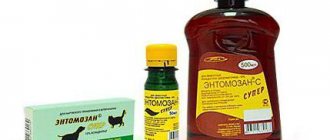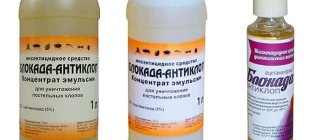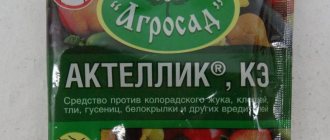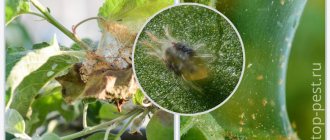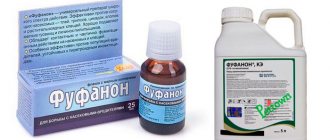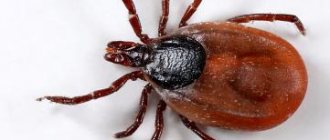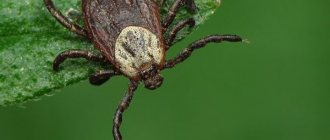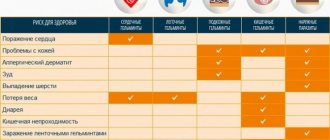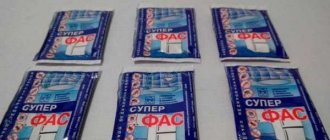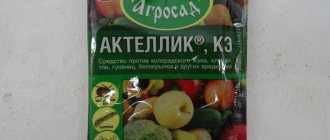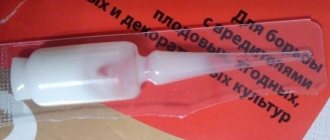Breeze 25% e. To." 25% consists of cypermethrin. It provides an insecticidal effect on insects. It also contains accompanying substances - a synergist, an emulsifier with a solvent. The acaricide looks like an emulsion with a high degree of component concentration and a light yellow color.
It is packaged in glass or polymer bottles with a capacity of 500 and 1000 milliliters, or polymer canisters with a capacity of 5 liters, which are marked with a warning that the contents are dangerous for fish and bees.
The concentrate is usable for two years from the date of manufacture, and the working water substance, in which cypermethrin is present in 0.01-0.05% content, is only six hours after readiness.
As an insectoacaricide, the drug has a powerful effect on mosquito populations and mosquito components, making it a worthy competitor to other produced chemicals. It affects the imago and larvae of individuals in twenty minutes, with a residual effect in the aquatic environment - up to three weeks, in natural conditions - up to four, in enclosed spaces - up to four months. The period is affected by the concentration factor and the type of surfaces.
Ticks are also successfully destroyed using Breeze 25% e. To.". The drug is prohibited for killing insects in fish and bird breeding areas, but is effectively used to neutralize standing water resources and objects for various purposes, places with abundant vegetation.
Why are ticks dangerous?
The danger of ticks lies in the fact that they are capable of carrying infections that are harmful and in some cases fatal to humans - encephalitis, tularemia, borreliosis, Lyme disease. When this arthropod bites, the virus immediately enters the bloodstream, rapidly spreading throughout the body. It is important to detect a tick on yourself in time and immediately seek help from specialists.
After being in nature, be sure to immediately check your entire body for tick bites, and if necessary, immediately seek medical help.
A little about the drug "Breeze-Antiklesch"
All anti-tick drugs can be divided into several types:
- acaricidal - agents that have a fatal or paralyzing effect on ticks;
- repellent - act by repelling ticks;
- combined - products that combine 2 effects - acaricidal and repellent;
- folk - can be both acaricidal and repellent, their peculiarity is self-preparation based on folk recipes.
Chemical repellents are more popular because they cause minimal harm to humans, do not have unpleasant odors, and do an excellent job of repelling ticks.
Acaricidal and combined preparations should never be applied to the skin or sprayed near the human respiratory tract. They are designed not only to repel ticks, but also to kill them. The latter is due to the high content of harmful substances in such products, so they pose a serious threat to human health.
The drug "Breeze-Antiklesch" is acaricidal, but at the same time it is intended specifically for human protection.
"Breeze Anti-Tick" is able to protect against ticks - the carrier of more than 40 viral diseases known to man
Composition of the drug
The product has been developed over 15 years to protect employees of law enforcement agencies from pests. It contains several effective components, each of which performs a specific function:
- α-cypermethrin is the main active ingredient, instantly paralyzing the parasite upon contact;
- isopropyl alcohol - dissolves α-cypermethrin, allowing it to be evenly distributed over the surface and effectively influence the pest;
- hydrocarbon filler (propellant) - provides the pressure in a cylinder with a liquid chemical necessary for high-quality and effective spraying of the product onto the surface;
- flavoring
The concentration of the active substance α-cypermethrin per bottle of the product is 2.5 g/l, which corresponds to acceptable standards.
Thanks to its composition, the drug “Breeze Anti-Tick” is able to protect a person from ticks for 5 to 15 days
How does “Breeze-Antikilesch” affect ticks?
The drug affects pests by paralysis. As soon as the tick comes into contact with the treated area of clothing, it is completely paralyzed. Everything happens instantly: you may not even notice the attack attempt.
How toxic is the drug?
Breeze-Antiklesch is no more toxic than other similar drugs. The percentage of all chemical components in its composition does not exceed acceptable standards. If you consider that you will not use the product all year round, but during certain periods, then the benefits in the form of protection from tick bites and possible infection with serious viruses significantly outweigh the possible harm.
Cost of the product
In different regions of Russia, the cost varies from 160 to 230 rubles for 140 ml of the product and from 270 to 320 rubles for a 270 ml bottle of the drug.
The real developer and manufacturer is a company from the city of Tyumen. Be sure to pay attention to this when purchasing the product. The container must be filled with liquid with the active substance to 65–70% of the total volume. The rest of the space is taken up by the propellant. Unscrupulous manufacturers fill the container with the active substance in liquid form only halfway or only 1/3 of the capacity. Be careful and don't fall for their tricks.
Disinsection against ticks
Every year, with the onset of warm weather, we carry out disinfestation against blood-sucking insects throughout the Moscow region and surrounding areas.
Most of our clients order regular annual treatment and spend the entire summer without fear for their health.
Who may need our services
Country houses and summer cottages
The largest number of our clients are owners of country real estate.
After disinfestation, summer passes in comfort and safety.
Parks and public areas
The protection of people and animals is the primary task of city services.
Parks, squares, and playgrounds must be safe for residents.
Social Events Areas
Places for festivals, concerts, country parks.
Mandatory protection of such areas will ensure the comfort of vacationers.
Fields and coastal area
Fields, forested areas, shoreline of reservoirs.
The main breeding ground for blood-sucking insects.
Tick treatment may be required in any area where there is vegetation and where there is a need to protect people and animals from tick attacks.
Whether to call specialists to protect the territory from ticks or not is a conscious choice of land owners. Everyone must decide for themselves whether they will carry out professional acaricidal treatment. But if you compare the real threat with the cost of disinfestation, the conclusion is simple. Protecting yourself and your loved ones is simple and very inexpensive.
Acaricidal treatment against ticks will reduce the risk of being bitten to almost zero.
What does a bite look like? The parasite attaches to a person or animal through a growth called the proboscis.
It is at the same time a sensory organ, a type of fastener, and an organ for blood sucking. The tick suction to the skin occurs from bottom to top:
- Groin;
- Lower back and abdomen;
- Chest and armpits;
- Ears.
After a bite, saliva penetrates the skin. In this case, a slight injury occurs, allergies and local inflammation occur.
The place where the tick attaches itself causes pain later, it begins to itch, and redness occurs in this place.
When Lyme disease appears, a red spot appears at the site of suction, which then significantly increases in size. The spot usually has a round shape.
A bluish spot appears in the center of the lesion. Later, a crust and scar appears at this place, but often it goes away.
Signs of an insect bite At the time when the bite occurs, no painful symptoms are observed in the person.
A tick that has burrowed into the skin can go completely unnoticed for a long time. About a few hours after the bite, the first characteristic signs appear: fatigue, drowsiness, chills, aching joints and fear of light.
The first symptoms after a bite may be as follows:
- The appearance of tachycardia;
- Increase in temperature;
- Itching at the site of the bite;
- The appearance of skin irritation;
- Enlarged lymph nodes.
Subsequent symptoms after an insect bite:
- Nausea;
- Vomit;
- Difficulty breathing;
- Headache.
After skin lesions, you need to constantly monitor your body temperature. If it remains elevated for a long time, then this is one of the main signs of an infectious disease. If the infection gets inside, a fever may develop. Consequences after an insect bite
Consequences in the form of infections can be:
- Damage to the nervous system - for example, with encephalitis;
- Damage to joints up to loss of movement;
- Increased pressure and the appearance of arrhythmia;
- Damage to the kidneys and liver.
Actions to take after a tick bite. If a tick has attached itself to you, take a series of sequential actions.
The first and most important thing is to try to remove it from yourself. To do this, you can use regular sunflower oil.
You need to coat the damaged area of the body well with oil, the tick will leave the owner on its own.
It is important to catch the insect, since it may turn out to be a transmitter of any disease.
The live specimen must be stored at room temperature. If the insect is dead, then it must be stored in a box with ice.
In the future, the tick must be sent for examination to determine possible diseases.
If you have a tick bite, you should definitely go to a medical facility. They will certainly carry out all the necessary procedures in this case and prescribe treatment.
Instructions for using the drug "Breeze-Antiklesch"
The product is intended to be sprayed onto clothing, not human skin. Therefore processing takes time. The procedure can be divided into several stages:
- Prepare the necessary clothing (in which you will go to the affected area) by hanging it on hangers.
- Shake the bottle of product thoroughly.
- Point the outlet of the balloon at the clothing and carefully treat each section of the fabric at a distance of 10–20 cm without gaps. The substance must be sprayed onto 1 m2 for 15–20 seconds.
- The clothes will become a little damp. This is fine. Wait for it to dry completely, feel free to put it on and go without fear of being attacked by ticks.
When treating clothing with an anti-tick agent, pay special attention to cuffs, sleeves, collars, hats, etc. These are the areas that are most susceptible to attack and are loved by pests.
Acaricides
It is important to strictly observe the processing cycle - twice a season - spring and autumn. Among the acaricides there are such as Taran, Baytex and others. However, Medilis-Ziper clearly stands out among them.
Medilis-Ziper is a remedy against ixodid ticks.
Possessing a wide spectrum of action, it is active against ticks, flies, mosquitoes and other blood-sucking parasites. The positive quality of this product is its low toxicity, since it does not contain poisons, the use of which can negatively affect human health, and you can also treat the area or room yourself with this product. Suitable for processing:
- Medical premises and healthcare facilities.
- Industrial premises.
- Residential premises.
- Territories and natural stations.
Precautionary measures
When using the drug "Breeze-Antiklesch", observe the following precautions:
- do not spray the product or leave the container near hot objects;
- do not expose the container with the product to shocks or falls;
- Under no circumstances should the drug come into contact with the skin or mucous membranes (eyes, nose, mouth) of a person: if this happens, immediately rinse the affected area with water and, if necessary, consult a doctor;
- Treat clothing in well-ventilated areas, for example, on a balcony, to prevent excessive inhalation of the sprayed vapors of the drug.
It is not recommended to use Breeze-Antiklesch for children, pregnant and lactating women. But in a situation where there is a choice between protection against ticks and the use of a chemical drug, it is better to make a choice in favor of using a product in order to prevent the possibility of infection with viruses.
Breeze for the territory
Spetsbioservice LLC also produces liquid for treating areas against ticks. It is often used for spraying forests. But Breeze goes on sale in small packaging made of glass or plastic;
- 0.5 l;
- 1 l;
- 5 l.
The containers are marked as dangerous for bees (class I) and for fish (class P).
Breeze has a 25% long duration. It acts on flying insects for 1-4 weeks in open areas. Indoors, the validity period is longer: 1-4 months. The duration of action depends on the concentration of the working solution and the type of surfaces being treated. But for ticks, the period of exposure to the toxic substance is 2 times shorter.
Breeze anti-tick product
In relation to warm-blooded organisms, Breeze's poisoning ability is indicated as moderately dangerous. The product poses a certain danger if ingested through the mouth or if a fine 0.1 percent aerosol is inhaled. The inhalation effects of a solution with this concentration are classified as hazard class 2. The likelihood of poisoning through the skin is unlikely. According to this method, the product is classified as low-hazard.
Important!
These data refer to working solutions and not concentrated emulsions.
Compound
This is an analogue of another remedy against ticks and midges, Cypermethrin. Composition of Breeze intended for treating the territory:
- cypermethrin – 25%;
- solvents;
- synergist;
- emulsifier (emulsion stabilizer).
Synergists are substances that enhance the toxicity of pesticides, but are not poisons. Due to the presence of synergists, working solutions contain 0.01-0.05% cypermethrin.
On a note!
The shelf life of the working solution is 6 hours.
Instructions for use
The working solution must be prepared before use. The Breeze product is mixed with strained water and stirred for 5 minutes. The prepared solution is poured into a spray bottle and sprayed on the area. Product consumption per 1 ha is no more than 400 ml. An overdose of Breeze is unacceptable. When spraying, you must use special clothing and take precautions.
Since the main use of the product is forested areas on an industrial scale, the safety precautions for Breeze were developed taking these nuances into account. Minors and pregnant women are not allowed to work with the drug.
Important!
A drug that does not have a passport is prohibited for use.
When working with the product, personal protective equipment is required:
- overalls made of thick or water-repellent fabric;
- latex gloves;
- sealed monoblock glasses;
- respirator with gas cartridge or gas mask.
On a note!
The respirator should fit snugly to the face without squeezing soft tissue. If you smell the drug in the respirator, this is a signal that you need to replace the gas cartridge.
Breeze anti-tick product
After use, the rubber parts of the respirator are thoroughly washed and dried. The overalls are removed and ventilated. Wash when dirty or once a week in a soda solution. You can spray no more than 6 hours a day with a break of 15 minutes every hour.
Although rare, reviews of Breeze sometimes contain complaints of malaise after treatment.
Symptoms of poisoning and first aid
If you systematically spray Breeze, the product will sooner or later get into your eyes or skin. In this case, the eyes are washed with water. Drops of the product from the skin are carefully removed with a cotton swab, without rubbing, and the affected area is washed with soap and water. It is worse if the drug enters the body. In this case, intoxication occurs. Symptoms of cypermethrin poisoning:
- vomit;
- unpleasant taste in the mouth;
- nausea that worsens when eating or smoking;
- weakness;
- headache;
- salivation;
- respiratory irritation;
- abdominal pain.
When food poisoning occurs, the first thing to do is vomit. To do this you need to drink several glasses of water. After vomiting, drink a 2% baking soda solution. Second option: 10-15 tablets of activated carbon with a couple of glasses of water. If a person loses consciousness, he is turned over on his side, emergency assistance is called and no further measures are taken. Treatment of Breeze poisoning is symptomatic.
